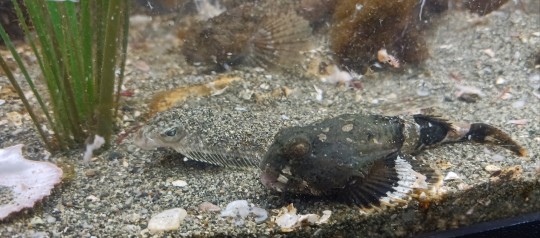#speckled sanddab
Photo

Speckled sanddab (Citharichthyes stigmaeus)
#speckled sanddab#citharichthyes ctigmaeus#flatfish#pleuronectodae#ichthyology#marine biology#pnw#wa#washington#salish sea#whulge#puget sound#ocean#les davis#tacoma
7 notes
·
View notes
Photo



Can you see the ultra camouflaged baby flatfish?
I’m not sure but I believe it is a Speckled Sanddab, Citharichthys stigmaeus
Edmonds Marine Park, Washington- January 20, 2020
#flatfish#scuba diving#edmonds#edmonds marine park#edmonds dive park#sanddab#speckled sanddab#citharichthys#Citharichthys stigmaeus#fish#fish identification#flounder#pacific sanddab#underwater photography#scuba photography#mine#scuba divers of tumblr#scuba diving edmonds#edmonds scuba diving#nature photography#marine life#marine bio#marine biology#fish id#flatfish id#flatfish identification#marine biologist#pnw#scuba dive#january 2020
41 notes
·
View notes
Note
TADPOLE DROWNER ANON BACK AGAIN first of all thank you for all the a+ drowner-specific content. Here's another tidbit to add from my sleepy reptile worker brain: what if drowners can do what baby false gharials (Tomistoma) do and actually change belly colour depending on how light hits. Or do like Crocodylus does and generally change btw lighter & darker shades depending on light. WHAT IF BABY DROWNERS MAKE THE SAME NOISES BABY ALLIGATORS DO. So cute. I cry
I AM... IMAGINING IT... OH MY GOD.... also I would be horrified if I came up on a pack of drowners and they made adult alligator noises, christ
[for those who don’t know what babbu crocodilians sound like: pew pew pew pew]
speaking of color changes that reminds me of this one sanddab I used to know who just absolutely refused to color-match the dark sand in his tank... there were three other sanddabs in there with him and they were all darkly speckled and camouflaged but not him. I’d have maybe said chromatophore issue except he was also like “hello I am going to wiggle up and down the glass for food every single time my tiny flat brain perceives a human” so I think he did in fact want to be noticed. and fed more, lmao. ofc sanddabs can control that and Crocodylus seem to do it automatically. but I love color changing animals there are so many of them! chams really are not that special.
#PEW PEW PEW PEW PEW...#like squeaky toys...#PEW#drowners#asks#anonymous#(we fed that sanddab twice a day he was NOT going hungry lmfao)
11 notes
·
View notes
Video
Speckled sanddab from my town’s marine life center
15 notes
·
View notes
Photo

@KateVylet: Sand-dwellers are so camouflaged sometimes they don't even see each other. Just as it was settling in, this red #octopus (Octopus rubescens) got a scare from a speckled #sanddab (Citharichthys stigmaeus). Based on the fish's acceleration, it's safe to say the spooking was mutual. https://t.co/MXfGDd9aI9
0 notes
Text


Speckled Sanddab
5 notes
·
View notes
Video
youtube
Footage from my dive this morning!
Rock soles, speckled sanddabs, helmet crabs, graceful crabs, red rock crabs, longnose crabs, snake pricklebacks, anemones, and more await you beneath the emerald sea surface off the shore of Steilacoom, WA.
#steilacoom#pnw#pacific northwest#ocean#sea#puget sound#sunnyside beach park#flatfish#crab#crustacean#brachyura#pleuronectodae#lepidopsetta bilineata#rock sole#speckled sanddab#pacific sanddab#graceful crab#metacarcinus gracilis#cancer productus#sand lance#gunnel fish#penpoint gunnel#saddleback gunnel#fish#marine biology#scuba#diving#eelgrass#seagrass
6 notes
·
View notes
Text


Speckled Sanddab (Citharichthys stigmaeus)
#eukarya#animalia#chordates#actinopterygii#pleuronectiformes#paralichthyidae#Citharichthys stigmaeus#Citharichthys#c. stigmaeus#flatfish#speckled sanddab
2 notes
·
View notes
Text

Speckled sanddab
1 note
·
View note
Text
youtube
Feeding time in Tank 705 at the MaST Center Aquarium, for which I volunteer at. The work I do is important, but unpaid. This is because it is all I can do in a capitalist economy that refuses to work with autistic people in the job market. Because of my week-to-week efforts, the MaST Center Aquarium remains free for all from 10am-2pm on Saturdays; our tanks are clean and our animals' bellies are full thanks to me and my fellow volunteers.
This goes to show that autistic people do have value and capabilities, despite what HR departments would have you think. People like me keep aquariums like this running. We keep these animals alive and healthy.
#mast center aquarium#sailfin sculpin#prickleback#gunnel#speckled sanddab#pleuronectidae#citharichthyes stigmaeus#pipefish#Youtube
1 note
·
View note
Text
Today's dive was wonderful! Oh man, where do I start?
My goal was to spend my dive observing rock soles, but unfortunately all of them wanted to keep distant beyond the water visibility. Save for one; who wouldn't flee for than a foot in response to my movements. One rock sole I was following into the current too a scarp right turn, perched, arced his body and lunged his face into the substrate. He spotted lunch and decided that was more important. A highlight of the dive was seeing THREE starry flounders! Last and first time I saw one was during my nav class dive. Two of them fled outside of my depth range and visibility, but one settled on the substrate and didn't bury himself. I got a good, long look at him; admiring his fin patterns.
Here's the magical part: after giving up the pursuit of one of the rock soles, I noticed a speckled sanddab move to get out of his way. I settled just above the sea floor before the little guy, and unlike the larger soles and flounder in this area, he actually moved closer to me! I thought it might be because he was fleeing in the other direction, but no, he stopped before me and hung out. Didn't bury himself at all. He check both sides of my out, and when I'd drift in the current, he followed me!
The sanddab wasn't the only one who felt inclined to sit close to me: Tens and tens and tens of island kelpfish surrounded me, resting on the seafloor. Only occasionally shifting positions. They would follow me with the drifting current, too! I do not know why these smaller fish preferred to be closer to me than the others, but I was in awe. I wondered if they felt safe around me; as though I were a predator deterrent. After all, remora and pilotfish keep close to the sharks.
The speckled sanddab had a curious wound. At least, I think it's a wound. It may have been infested flesh. It was situated behind the gill and extended a few millimeters posterior and covered most of that area. The flesh was a deep purple and pale purple. This sanddab was not having a good time, it seems. Disease or injury. (edited)
My secondary objective was to observe graceful crabs. Fortunately, there were several, and all were not afraid, though some were missing legs, and others were carrion. They didn't do anything interesting. There were some massive red rock crabs, as well. Far more active. There was male with the most fearsome set of claws I've seen, and there was another buried in a 10 gallon bucket that serves as an anchor for the guide ropes. His massive carapace was ominously outlined in the sand, and his watchful eyes were out. I wanted to see the rest of this beast, but it would be rude to uncover him. His carapace occupied half the area of the bucket. Can you imagine?
There were several helmet crabs scurrying about. Most notably, I discovered a mating pair by a loop anchor and a great sculpin. I left them to their love.1
I called it at 75BAR and 45 minutes because I was getting quite cold. The sun was out and it was a gorgeous day, but the water was snowy and 7.28 degrees C. That must be why we are having pleasant temperatures today. The water was 12 degrees C last Tuesday when the saws were breezeless and hot.
I am disappointed that I could not have captures all these wonders on film, like I'd planned. But I hope I've painted a vivid enough picture.
Next week, though, I will be able to record. Same place, same time of day, same goals. Though, now, I have a clearer picture of what I should be paying attention to. The prevalence of the smaller fishes in the South Sound to linger close to me, as opposed to larger fishes.
I am seal-sized, and I'm sure all those flounders and soles that fled probably assumed I was there to eat them. They are the right size for it.
There were several sharpnose crabs, too. I only saw one kelp crab--a small thing, and shy--because the tide was low and the sea grass beds nearshore were exposed to the air. I wonder where the kelp crabs went?
2 notes
·
View notes